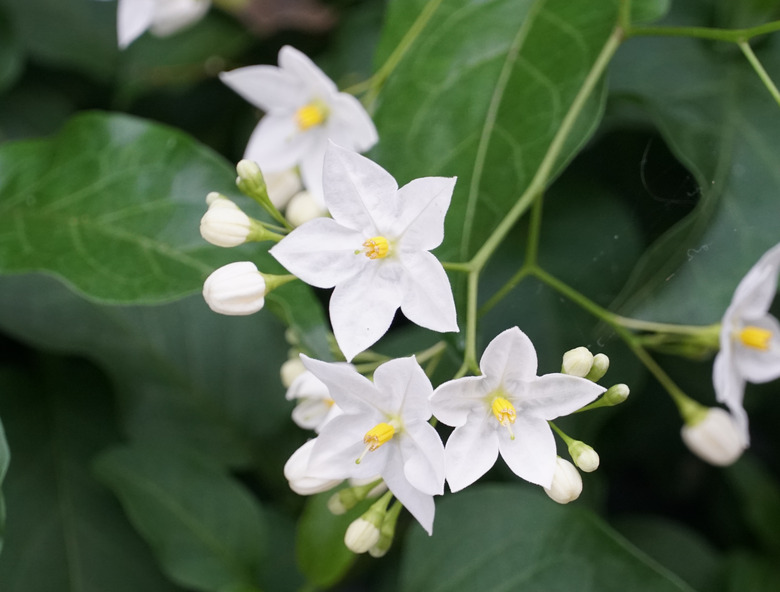How To Grow A Potato Vine Plant
We may receive a commission on purchases made from links.
The poor potato vine plant (Solanum laxum, USDA zones 8-10) ought to sue the person who saddled it with its misnomer. Despite most people's assumptions, this isn't a plant children grow by sprouting a potato's eyes. Not to be confused with the ornamental sweet potato vine (Ipomoea batatas, zones 9-11), which is prized for its foliage, potato vine boasts a profusion of showy star-shaped white blossoms that adorn vines up to 25 feet long. The potato vine plant is a decorative climber of walls or fences and ideal for a special spot in your garden, covering a lattice.
Potato Vine Plants
Potato Vine Plants
Potato vines may sound like they grow from lumpy potatoes, but they're not actually potato plants at all. These woody evergreen vines do happen to be in the nightshade family, like potatoes, which accounts for its common name. The species comes to us from the jungles of Brazil.
Potato vines grow very rapidly. Their slender stems with long, bottle-green leaves quickly cover their support, whether it's a column, wall, trellis or lattice. The delicate vine provides a dramatic backdrop for the showy, star-shaped white flowers. Spring is the time the potato plant puts on its most glorious floral show, but the vine produces blossoms year round in mild winter climates.
Gardeners aren't alone in admiring the flowers, as they also attract bees and hummingbirds. If the flowers become fertilized as a result of pollination, dark blue fruits can develop.
Grow a Potato Vine Plant
Grow a Potato Vine Plant
Potato vines are almost as easy to grow as potato tubers. You can grow the vine from seeds started indoors or from young plants purchased from the garden store. In either case, transplant the young plants to a site with average, well-drained soil. Select a location in full sun, like a south or west- facing fence or wall.
Assuming you're planting a potato vine in the ground, use a garden shovel to dig out a hole that is twice the size of the container the potato vine came in. Remove the plant with its root ball from the container. Set it in the hole at the same level with the soil and back-fill it with soil. For multiple vines, space them about 2 feet apart from each other.
Regular irrigation is important for these vines. Water potato plants frequently during the first growing season. This helps the vines establish a deep, extensive root system that will keep the plant vigorous. Once it's established and strong, change your irrigation pattern and water deeply and less frequently.
Care of Potato Vine Plants
Care of Potato Vine Plants
Fertilize the vines with an all-purpose fertilizer applied according to the label directions. Choose a granular slow-releasing fertilizer so you only need to do it once in the spring. Otherwise, you'll need to fertilize once every few weeks during the spring and summer months. Water your potato plant before fertilizing to keep the roots from being damaged.
Remember that potato plants are vines that require a support to grow up. You can plant them near a trellis or arbor, or train them to grow up a fence, wall or tree. Tie them to the support using twine as they begin to grow, then remove the twine once the roots take hold and the vines begin supporting themselves.
Pruning is also important to keep these vines a manageable size. Bring out the pruning shears in autumn after the summer flush of blossoms has passed. Cut back your potato vine in the late winter, just before spring. Cut it close to the ground, where it will grow back fuller and grace your flower garden with more blooms the next year if your garden is in its hardiness range. If you live outside this perennial range, you can dig up your potato vine and pot it up, bringing it inside for the winter before replanting it in the landscape the following year.
